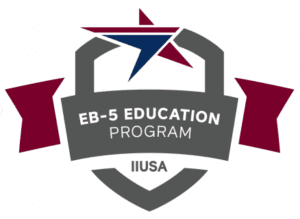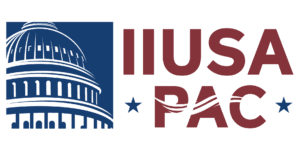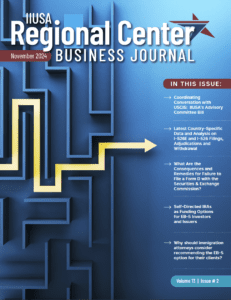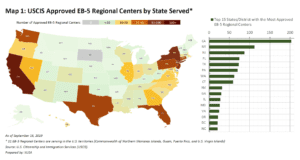|
The Invest In the USA (IIUSA) Board of Directors has voted unanimously in support of a bipartisan, bicameral agreement among the chairmen and ranking members of both the House and
 Senate Judiciary Committees to reform and reauthorize the EB-5 Regional Center Program (the “Program”). The vote followed a review of draft legislation which is the result of extensive discussions among Congressional leaders and industry stakeholders that began with the last Program reauthorization in 2012 and continued throughout the 113th Congress (2013-2014) in the context of broader immigration reform efforts and current 114th Congress (2015-2016). Senate Judiciary Committees to reform and reauthorize the EB-5 Regional Center Program (the “Program”). The vote followed a review of draft legislation which is the result of extensive discussions among Congressional leaders and industry stakeholders that began with the last Program reauthorization in 2012 and continued throughout the 113th Congress (2013-2014) in the context of broader immigration reform efforts and current 114th Congress (2015-2016).Under EB-5, a program created by Congress in 1992 with broad bipartisan support, foreign nationals who invest at least $500,000 or $1,000,000 in approved U.S. businesses are eligible for permanent residency if the U.S. government confirms that their investment created at least 10 American jobs within two years of the investment.
Congress has not addressed needed EB-5 program reforms since its inception, despite explosive growth in the Program. After years of underutilization, EB-5 became an important source of investment capital following the Great Recession. Since 2008, the Program has generated more than $13 billion in foreign direct investment that created tens of thousands of jobs, and there currently is more than $9 billion in EB-5 capital pending approval at USCIS.
“The EB-5 Program has finally come into its own, and with this tremendous growth comes a need for reform,” said IIUSA Executive Director Peter Joseph. “We greatly appreciate the hard work that Senator Grassley, Senator Leahy, Congressman Goodlatte, Congressman Conyers, Congressman Issa, Congresswoman Lofgren and the Judiciary Committee staff have devoted to crafting a thoughtful bill that will strengthen needed oversight, national security and securities enforcement activities that the IIUSA has long encouraged and supported. These reforms are important to the program reauthorization and should be enacted now.” In a letter sent to the House and Senate Judiciary Committee leaders, IIUSA communicated its support for moving ahead with the legislation and outlined the organization’s priorities for re-authorization. The organization believes that, on balance, the bill’s provisions achieve real reform with minimal disruption to ongoing job-creating economic activity and a fair market for attracting investors going forward. A discussion draft of the legislation was issued this morning on behalf of the bipartisan, bicameral judiciary committee leadership managing the bill’s passage. An outline of the proposal can be found here.
“Throughout the negotiation process, IIUSA remained hopeful that our shared commitment to strengthening program integrity and improving the program’s effectiveness as a job creation tool would lead to a long-term reauthorization that addressed concerns expressed by Members of Congress and federal oversight agencies as well as the interests of the industry. These reforms are urgently needed and the time is now to enact this important bi-partisan agreement so IIUSA’s members can continue their work creating American jobs. We want to thank the Committee for the opportunity to provide input based on the real-world experience of our members,” said Joseph.
Founded in 2005, IIUSA is the national non-profit trade association for the EB-5 Regional Center industry with a mission of advocacy, education, industry development and research. The organization represents more than 280 Regional Center members and 230 associate members, collectively representing big and small projects, urban and rural economic development, and industry sectors ranging from real estate and manufacturing to energy and infrastructure. IIUSA’s members are engines of economic growth and job creation, accounting for over 95 percent of capital flowing through the Program.
|
|
|
How can you help the advocacy effort?
Now…as in TODAY…is the time for you to reach out to your representatives in Congress and ask them to contact the congressional majority/minority leadership offices (and Speaker of the House) along with chairs/ranking members of the Appropriations Committees in both the House and Senate. Urge them to support the bipartisan, bicameral agreement between the House and Senate Judiciary Committee leadership in the omnibus. It is important that Congress not only hear from you, but also the beneficiaries of EB-5 in your communities (such as private businesses, chambers of commerce, municipal governments, economic development partners, employees, etc.) about why EB-5 is such an important job creation tool in the 21st century.
Lastly, we invite you to come to DC next week to visit Capitol Hill to advocate for EB-5 in person! IIUSA’s offices are steps from Capitol Hill and we are stocked with everything you need to be an empowered and effective advocate for our industry. We are happy to assist with scheduling meetings with congressional offices and have plenty of space for you to set up in our offices to coordinate our efforts. Please contact us at [email protected] for further information.
|
|
|
How did we get to this point?
The Board vote followed a review of draft legislation that is the basis of the agreement among House and Senate Judiciary Committee leadership. The draft is the result of extensive discussions among Congressional leaders and industry stakeholders that began with the last Program reauthorization in 2012 and continued throughout the 113th Congress (2013-2014) – in the context of broader immigration reform efforts and high profile Congressional oversight scrutiny – and current 114th Congress (2015-2016). The version of the legislation that we reviewed incorporated a vast majority of IIUSA’s comments on a previous draft that was circulated to membership in early November. Getting some of those comments incorporated on major issues was extremely difficult, especially the issue of “effective dates” which was the last major hurdle to an agreement, as there is significant support in Congress for some kind of retroactive application of reforms onto investors who filed I-526 petitions before the date of enactment (and as we know, there has been a large spike in filings in the last six months). The agreement among the Judiciary Committee leadership ensures all investors with pending petitions will be adjudicated under the rules in which they filed.
To recap this year, after the introduction of S. 1501 (American Job Creation and Investment Promotion Reform Act of 2015) on June 3, 2015, which was co-sponsored by the Chairman and Ranking Member of the Senate Judiciary Committee, IIUSA responded with comprehensive comments in a letter dated July 17, 2015. Later in the year, IIUSA sent a compromise proposal to Congress on how to approach the four major issues perceived to be impeding progress towards a long term re-authorization of the Program: effective dates, targeted employment areas (“TEAs”), minimum investment amount, and job creation methodologies. The compromise was recommended and supported unanimously by the IIUSA Board of Directors, and also received unanimous support from IIUSA’s Public Policy Committee and the vast majority of our membership in a poll (83%). Most recently, IIUSA provided comments on a bipartisan and bicameral discussion draft in a letter dated November 20, 2015 that sought to address all remaining issues in time for Congress to pass long term re-authorization legislation and was satisfied enough with the resulting draft to move ahead with supporting the effort of judiciary committee leadership.
|
|
|
Is there opportunity to offer technical corrections to the legislation before it is enacted?
Yes and we welcome your suggestions. IIUSA remains in daily contact with key congressional offices and will keep this up as the process moves forwards from here and until we get this reauthorization successfully across the finish line. There is likely limited opportunity to offer minor revisions to legislative language that maintain the spirit or intent of the existing provisions. We believe supporting the judiciary committee leadership agreement will provide the best opportunity to have such suggestions considered by Congress.
There are also other ways to build the record of Congressional intent to clarify certain provisions, such as statements or submissions on the Congressional Record by Members of Congress and the regulatory/rulemaking process that will follow enactment of the law. Again, we believe supporting the judiciary committee leadership agreement will provide the best opportunity to make the best use of such policymaking tools.
|
|
|
What happens next?
Congress must pass legislation to omnibus appropriations funding for the federal government by next Friday. There is no guarantee that they make that deadline and there are reports that they could even extend federal government funding at existing levels for a week while the full package is finalized (that is a discussion for another day, if we have to go there). The large piece of legislation will include additional program authorization packages that have bipartisan, bicameral support from leadership of the authorizing committees (such as EB-5). Accordingly, there are internal deadlines within Congress for submission of these additions to the legislation to congressional leadership. The full omnibus appropriations bill will first be considered by the House of Representatives before the Senate, and then be sent to the President to sign into law, all within the next week.
|
|
|
What are “omnibus appropriations”?
In the legislative context, “omnibus appropriations” means a government funding bill that appropriates funds according to a budget agreement that is reached outside of the regular order process that Congress is supposed to follow for budget and spending authorizations (and which has not been done to full completion in over ten years). This particular omnibus legislation is based on a budget deal that was reached at the end of October just before House experienced a change in leadership in the Speaker’s office. The EB-5 Regional Center Program was created as a rider to appropriations legislation in 1992 and has been reauthorized the same way every time except for 2012, the first time it was considered as a stand-alone package with three other non-controversial immigration-related programs: e-verify, CONRAD30, and religious workers. We expect all four programs to be reauthorized on the appropriations legislation for the same period of time.
|







